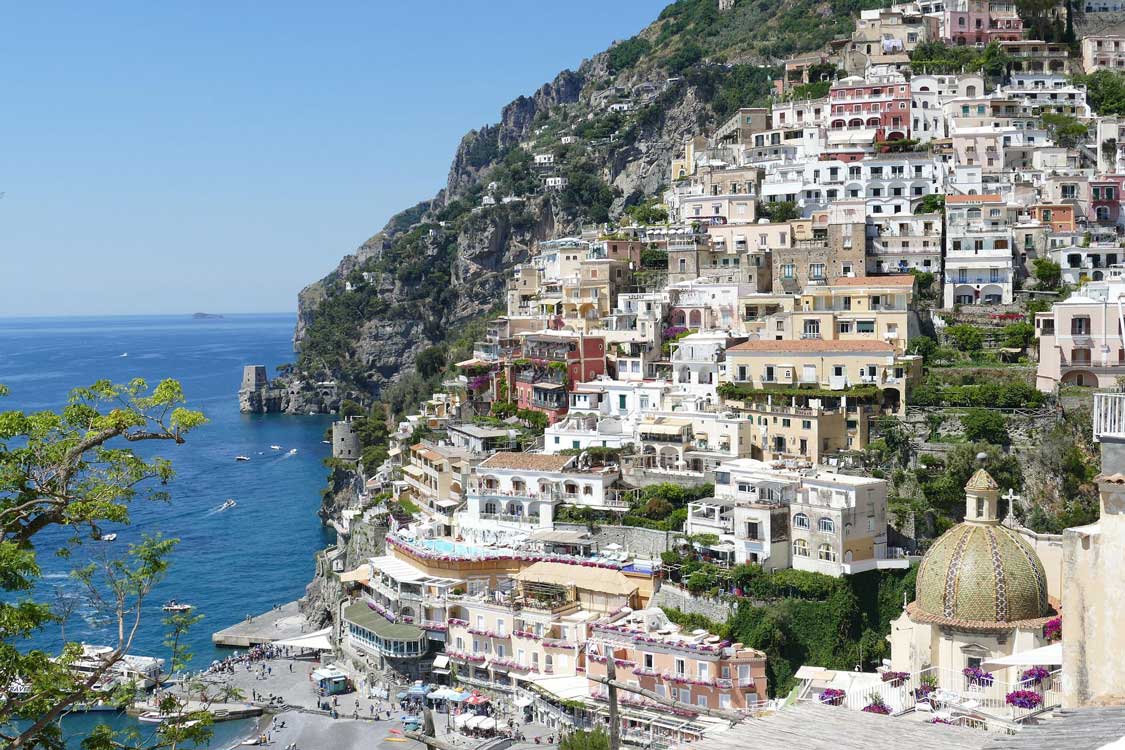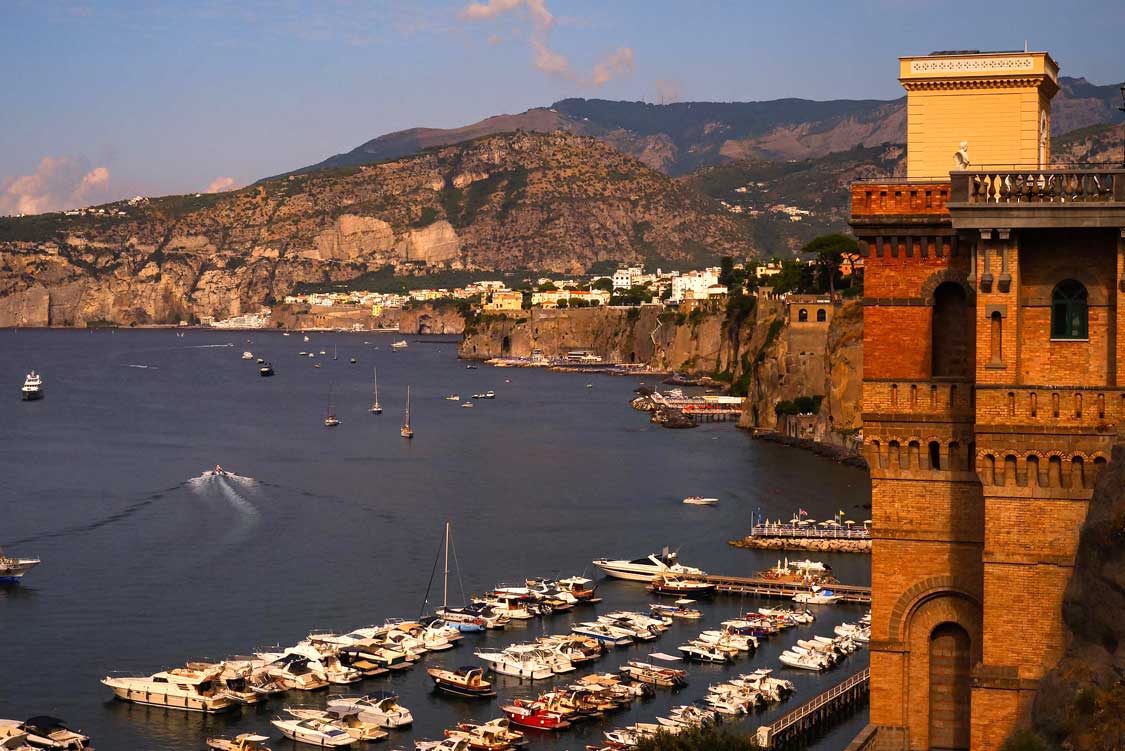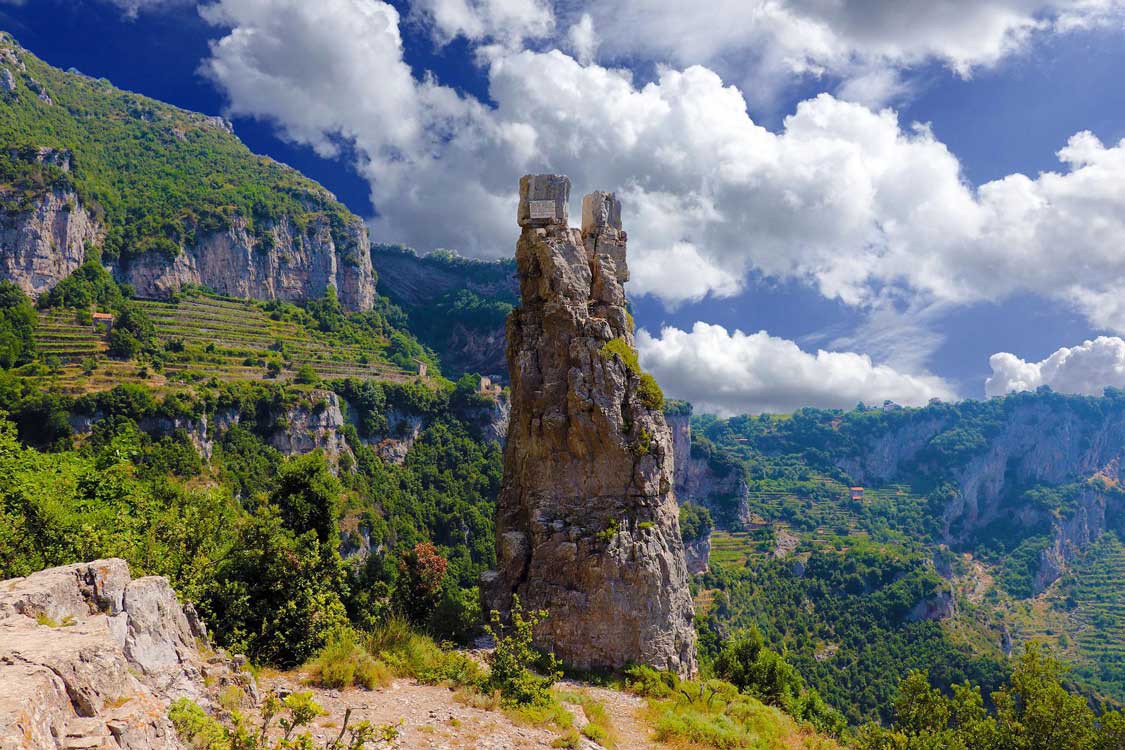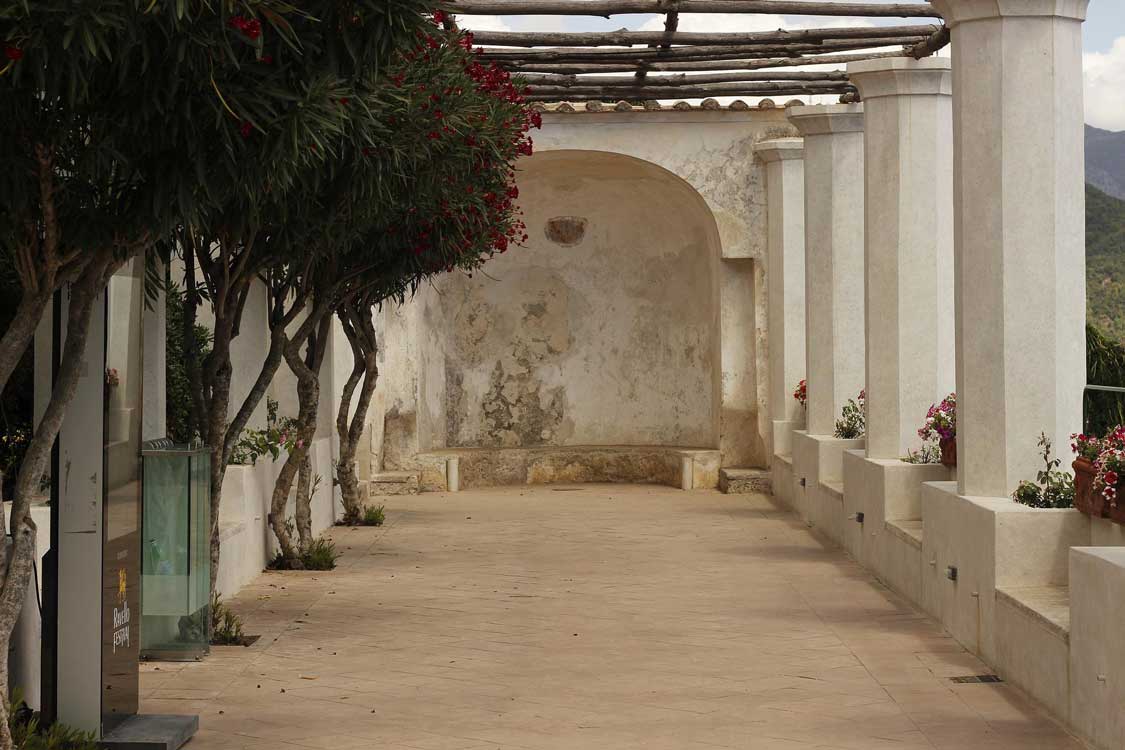This journey through the Amalfi Coast food experiences will tell you exactly where to eat on Italy’s most beautiful shores.

Trying to describe the breathtaking scenery of Italy’s Amalfi Coast could bankrupt the English language.
Corkscrewing around the corniche of hairpin turns from Sorrento to Ravello is arguably one of the planet’s most giddying, toe-clenching drives. Although the two share the same nation, the food of the Amalfi Coast is a far different experience from the flavors of Rome and other regions of Italy. You might find dishes like Caprese Salad on the menu, but there’s something that the coastal landscape offers that just can’t be replicated elsewhere.
Some twists require a three-point turn as they zip past vertical cliffs, rising as high as 300 meters before they immediately plunge into the impossibly blue Tyrrhenian Sea. Gravity-defying towns cling to the precipices amongst a landscape of terraced olive and lemon groves.
The Amalfi coast pinches into the Tyrrhenian Sea, pointing out to the island of Capri off the Sorrentine Peninsula. The most famous towns along the Sorrentine Peninsula are Sorrento, Positano, Amalfi, and Ravello. But there are several lesser-known charming fishing and mountain villages along the route.
This fabled Italian Eden in southern Italy’s Campania region has attracted visitors since the Middle Ages. Celebrities, acclaimed writers, and musicians have all swooned over the considerable charms of the Amalfi Coast.
In 1997 the Amalfi Coast was named a UNESCO World Heritage Site, solidifying its importance as one of Italy’s most important cultural centers, as well as one of the country’s most beautiful.
What Is The Best Time To Visit the Amalfi Coast?

The best time to visit the Amalfi Coast is from April to June or September to October when the climate is mild, there are fewer tourists, and accommodations cost less than summer high season rates.
During these months, expect beautiful weather and lots of activities, both inland and on the water. Temperatures normally sit at a delightfully comfortable 68°F to 77°F.
If escaping the crowds is your thing, visit the Amalfi Coast between November to March when crowds are at their lowest, and the weather is slightly cooler.
The Food of the Amali Coast
Blessed with rich volcanic soil, plenty of sunshine, and a sea teaming with all sorts of fish, the Amalfi Coast is a food lover’s paradise.
Try spaghetti alle vongole (spaghetti with clams) washed down with a glass of crisp white Falanghina wine. Finish with delizia al limone (lemon-scented sponge cake) with lemon zest icing.
Amalfi lemons are sweeter, bigger, and more bulbous than lemons found elsewhere. The two types grown on the Sorrento Peninsula — the Sfusato Amalfitano and the Limone di Sorrento are among the most highly prized lemons in the world.
Limoncello liquor originated here and is yet another reason to toast the flavors of the Amalfi Coast.
I have visited this enchanting corner of Campania several times and am convinced that the best way to travel is via the SITA bus system or by ferry.
The cost for a bus ticket from Amalfi to Ravello is €1.30; the taxi fare is €40. The bus gets you there just as fast as a car, and the drivers are experts armed with very loud horns.
Ferries on the Amalfi Coast connect several towns. Schedules vary depending on the season. My husband and I managed 20 days using just a carry-on bag each and a small backpack.
Sublime Sorrento

An hour train ride takes you from the traffic-congested, noisy city of Naples to the sleepy streets of Sorrento, the ideal spot to start soaking up the Amalfi atmosphere. And what better place than on the terrace of Grand Hotel Excelsior Vittoria with a Bellini cocktail where the hazy outline of Mount Vesuvius looms on the horizon?
Five acres of lemon-scented gardens and white-glove service recall the bygone days of the Grand Tour, for which this Grand Dame of Sorrento hotels was built in 1834.
Take a leisurely stroll through Sorrento’s medieval heart around Piazza Tasso, then head to the seafront promenade at Marina Grande where seafood restaurants beckon. I recommend O’ Puledrone, owned by a family of fishermen, for spaghetti vongole or whatever the catch of the day happens to be.
An Amalfi Coast food experience not to be missed is the tasting menu at Don Alfonso 1890 in nearby Sant’ Agata Sui Due Golfi.
Reputed to be the best restaurant on the Amalfi Coast, this Michelin-starred member of the Relais & Châteaux association is proudly owned by the Laccarino family. Ask for a tour of the cellar, once a Roman tunnel, with its cheese aging room and upwards of 30,000 bottles of wine.
Should you wish to savor this bit of heaven a little longer, book a room and enroll in a cooking class. Reservations recommended.
Posh Positano

A few kilometers and countless perilous turns down the road from Sorrento, you’ll reach Italy’s most vertical town, Positano. Here, you can gaze upon pastel villas spilling from the vertigo-inducing cliffs. I doubt they sell many Stair Masters in horizontally challenged Positano, so best you leave your stilettos at home.
Wind your way through the maze of boutiques and cafés down to the Santa Maria Assunta church crowned with a green and yellow majolica dome and cupola, then head over to the Spiaggia Grande (main beach), where you’ll find some of the best restaurants in Positano, Italy.
Chez Black is a favorite with their scrumptious takes on sea urchins, hearty Fish Soup, and their Paccheri pasta with Positanese sauce. Or you can wave down the boat with the red fish on the mast at the main jetty for some ultra-fresh delicacies. It leaves at 10 a.m. in the mornings for Da Adolfo, a laid-back trattoria a few coves away on Laurito Beach.
Plan to spend an indulgent afternoon enjoying the house specialty, buffalo mozzarella grilled on a lemon leaf, followed by seafood spaghetti. Enjoy a siesta on a shaded beach bed, then sip white wine spiked with peach nectar until the boat returns to Positano at 4 p.m.
Perhaps John Steinbeck best captured the experience when he penned, “Positano bites deep. It is a dream place that isn’t quite real when you are there and becomes beckoningly real after you have gone.”
Idyllic Amalfi

The next stop on our journey through Amalfi Coast food is the tiny, exuberant town of Amalfi. This quaint village was one of Italy’s most powerful trading ports back in the 9th century, which explains the Moorish architecture of the Cathedral of Sant’ Andrea dominating the main square.
Treat yourself to lunch in a lemon garden at Pizzeria Donna Stella. Shop for lemon souvenirs (soap, limoncello, candies, pasta) as the Amalfi shores are famous for their fragrant Sfusato Amalfitano citrus variety.
Later, join the locals in their passeggiata, a traditional evening stroll around the central piazza to socialize and perhaps enjoy a spritz cocktail at the posh Pranzi café.
I think you’ll be inclined to agree with the inscription on a plaque under the town’s Porta Marina that bears the inscription, “The judgment day, when Amafitans go to Heaven, will be a day like any other.”
Ravishing Ravello

When my judgment day arrives, the village of Ravello is where I’d like to have my ashes sprinkled.
Perched 1,100 feet above Amalfi, Ravello has been described as “closer to heaven than the sea.” The town’s known for it’s flora. And the two must-see garden glories are the Villa Cimbrone and Villa Rufolo. Author and one-time resident Gore Vidal remarked that the panorama from Villa Cimbrone is the “most beautiful view in the world.” Indeed, the view from the Belvedere of Infinity, a stone parapet adorned with stone busts overlooking the entire Bay of Sorrento, is mesmerizing.
The cloisters of the Villa Rufolo were Richard Wagner’s inspiration for Klingsor’s Garden in his opera Parsifal. The clifftop aerie is now the setting for a summer concert series where the stage is suspended over the sea.
This year, my Ravello highlight was my day at Mamma Agata’s Cooking Class. Mamma, one of seven children, was born in 1942 when post-war times were tough.
At age 13, she landed a job as a cook for a wealthy American socialite who often entertained the rich and famous in her villa. Humphrey Bogart, Fred Astaire, and Jackie Kennedy all swooned over Mamma’s traditional dishes. Eventually, Mamma started offering cooking classes in the family home. These days Mamma has passed her wooden spoon onto her daughter, Chiara.
The group that I was cooking with met on the patio overlooking terraced gardens, lemon groves, and the blue sea below. Classes started at 10:30 with cappuccino and Mamma’s famous lemon cake (Humphrey Bogart’s favorite). Then we head into the kitchen, where Chiara warns, “you will taste a massive amount of food.”
She makes a “mother” tomato sauce that will be the base for eggplant Parmesan. Next is a Bolognese ragu that simmers for three hours. For her cherry tomato marinara sauce, Chiara drops thin garlic slices into olive oil, creating what she calls “Prosecco” bubbles and an aroma of “Italian Chanel.” The smell fills the kitchen. Next, she demonstrates how to make meatballs that are “as light as clouds.”
When lunch is served, I can honestly say that each dish was the best of its kind that I have ever tasted. We toasted our feast with house-made limoncello dubbed the “Italian Viagra.”
Viva La Dolce Vita.
You can find all the details for Mama Agato’s Fresh Cherry Tomato Sauce Recipe here.
Pin This For Later

